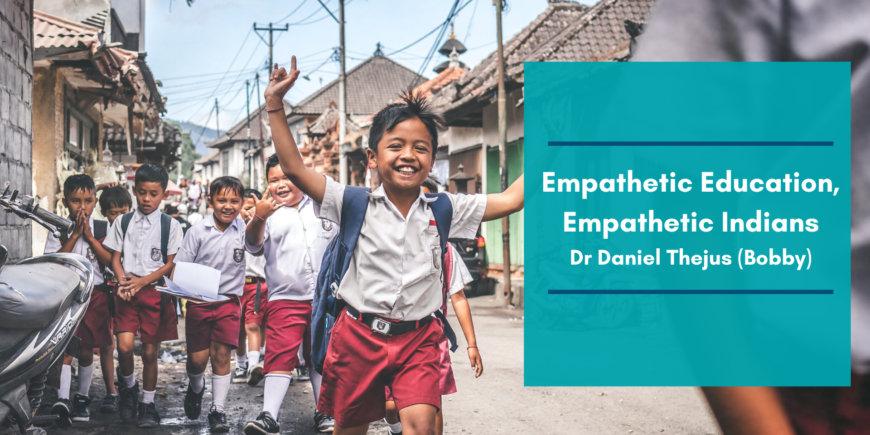Empathetic Education, Empathetic Indians
Reports of police killing civilians, public pelting stones at doctors, ending rent contracts, and other heartless acts sadly reflect the lack of empathy on our part as Indians. I wondered where the fault might lay and various cultural and religious excuses popped up. However, I think the problem lies in our system of education too. It simply doesn’t take our well-being into consideration.
Many of us can relate to how fear was effectively used to remind us that we mustn’t question what our teachers say and that we will be mocked at for not answering a question appropriately. 12 years of this system reduces many of us to blind followers of the pack who take the emotions of others for granted.
Don’t get me wrong, of course, the Indian system can and has produced high-quality students, but the question of empathy and critical thinking still looms large. There is an urgent need to help our children – this includes state-run schools in remote areas as well as in cities – to operate creatively, confidently and compassionately keeping student’s well-being at the fore.
This does not have to be the case. Nobel Laureate Rabindranath Tagore illustrates the issue in this witty story.
“Textbooks can never be too many for our purpose!” proclaims a pundit to the Raja who is convinced that his parrot needs to be educated. They commission a beautiful structure, put a very impressive curriculum in place and the method of instruction is clear and precise. The king leaves his nephews in charge.
‘The method was so remarkable that the bird in comparison seemed plain.’ The teachers went about with a textbook in one hand and stern discipline in the other and gave the poor bird ‘what may fitly be called lessons!’ In the process of this great endeavour, the bird dies and nobody notices. Days later the king’s nephews return to report to him:
The nephews say, “Sire, the education of the bird is complete.”
“Does it hop?” the Raja enquires.
“Never!” said the nephews.
“Does it fly?”
“No.”
“Bring me the bird,” says the Raja.
The bird is brought … The Raja pokes the bird’s body with his finger. Its inner stuffing of book leaves rustles.[1] This story is testament to what can happen to our children; fall in line at the expense of sacrificing an intrinsic self for the cause of the herd. Mustn’t there be a way for the self to thrive as an individual so that the herd might benefit from it too?
Tagore countered this by starting a school where the emphasis was going to be on freedom, creativity, and eventually a transformed soul. These principles can easily be replicated in rural areas without dismantling too much of the existing system. Learning can take place in a natural environment under a tree, perhaps, or even beside a stream. It is based on both classical Indian methods and contemporary developments in education. The freedom to think freely and love learning – because it has the potential to dispel darkness with light – is the ideal outcome of Tagore’s Santiniketan.[2]Tagore himself is an example of a critical mind, marked by creativity and freedom, who made positive contributions to the cause of India’s freedom struggle.
Indira Gandhi commented that it was in Santiniketan that she enjoyed and learnt the most in comparison to all the elite schools that she had been to. Some other eminent personalities who studied there were Princess Gayatri Devi of Jaipur, the famed director Satyajit Ray and Abdul Ghani Khan the poet.
Empathetic Education can make a big difference. Nobel laureate Amartya Sen, another alumnus of Tagore’s school, says his perspective on education was altered when he heard one of his teachers say of a girl, “She is quite a serious thinker, even though her grades are good.”[3] Students in empathetic environments quickly realize that their worth is based on fulfilling their multiple strengths rather than just their grades.
Martin Seligman, in his seminal research work, found out that well-being builds character, helps in communication, and gives confidence. This, in turn, Seligman points out, results in improved grades. To help us, he turned his many years of research into a simple acronym – PERMA – which stands for Positive Emotion, Engagement, Relationships, Meaning and Achievement.
Let me quickly explain how the first letter P of the acronym might work. Positive Emotion in class can be encouraged, for example, by asking students how they felt about a difficult maths lesson and how they overcame that difficulty. A student might reply that a friend helped her to understand it. In that simple exchange, two traits that build character can be observed. One is gratitude from the one who is being helped and the other is empathy from the one who helped the weaker student.
Educators in many parts of the world have incorporated PERMA into every lesson that they teach. And the positive effects are just mind-boggling.[4] It’s so effective that COURSERA offers a free course – https://www.coursera.org/learn/teaching-character#about – for anyone who can make a difference in the lives of children. And if you have time to spare during the week, you can probably help a government school near you, or perhaps you have other avenues to help children in your neighbourhood?
I believe we can all help create an India that is both smart and sensitive! If you happen to be a Christian who celebrates Easter, then you are invited to participate in creating a bit of heaven here on earth. After all, Jesus did say, “For the kingdom of heaven belongs to such as these.”
————–
[1] Idem, “The Parrot’s Training,” in Rabindranath Tagore: An Anthology, ed. Krishna Dutta and Andrew Robinson, trans. Krishna Dutta (New York: St Martin’s, 1997), pp. 284- 330. For an internet source on this and other works of Tagore see, http://www.tagoreweb.in/Render/ShowContent.aspx?ct=Stories&bi=4A57AB73-A4A0-40D5-551D-9502E9CD11FD&ti=4A57AB73-A4A0-4FB5-251D-9502E9CD11FD
[2] See, https://newlearningonline.com/new-learning/chapter-2/supporting-material-1/rabindranath-tagores-school-at-shantiniketan
[3] http://www.nobelprize.org/nobel_prizes/economics/laureates/1998/sen-speech.html accessed on 22, May 2020.
[4] https://www.abdn.ac.uk/education/research/eitn/journal/534/

